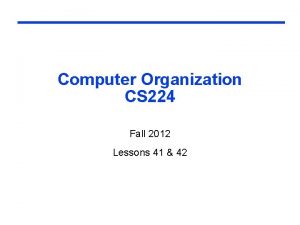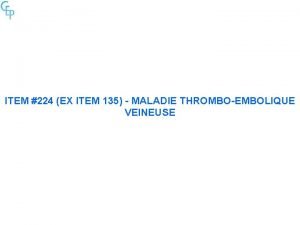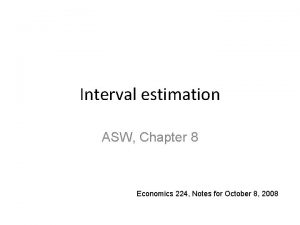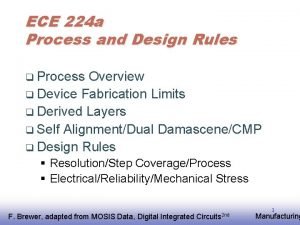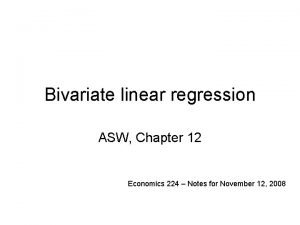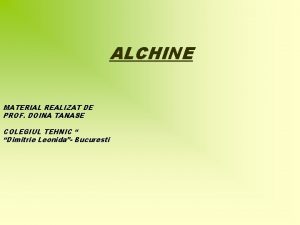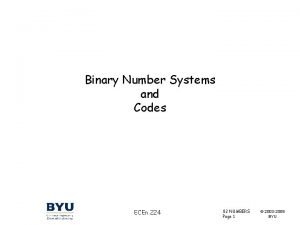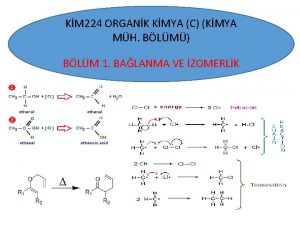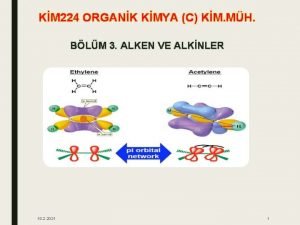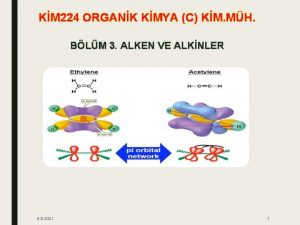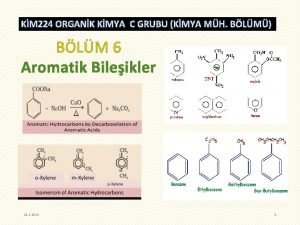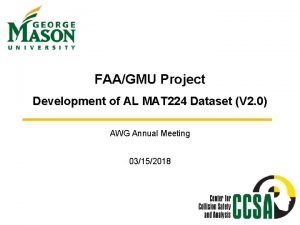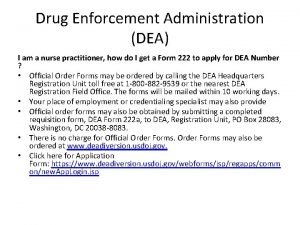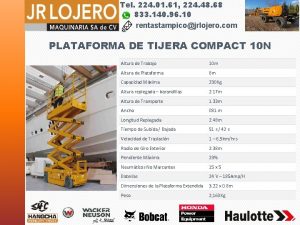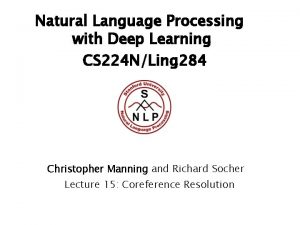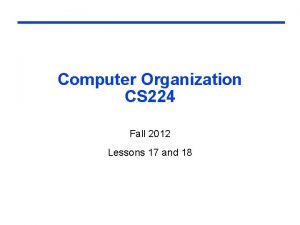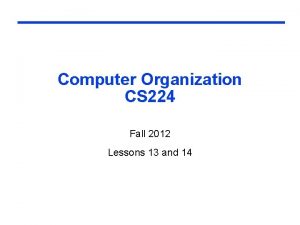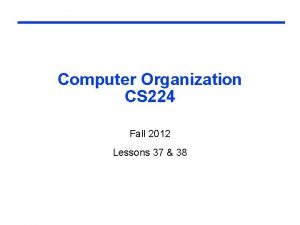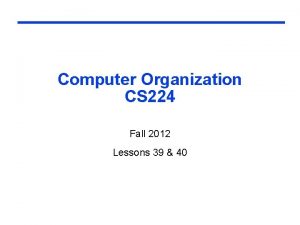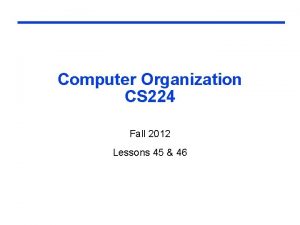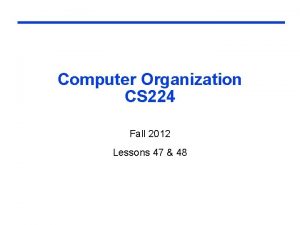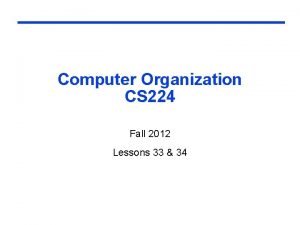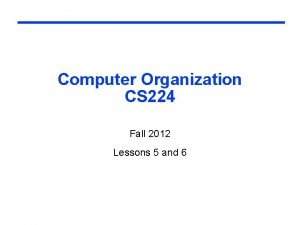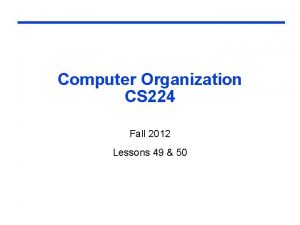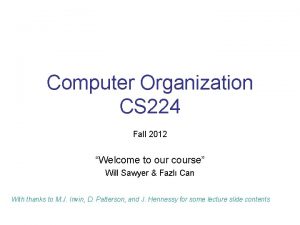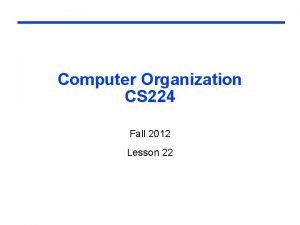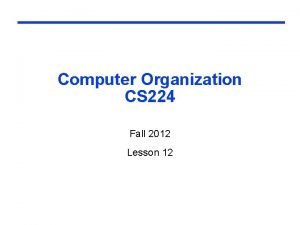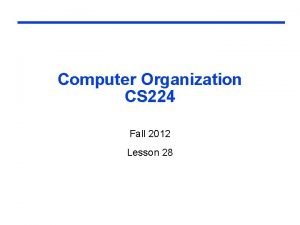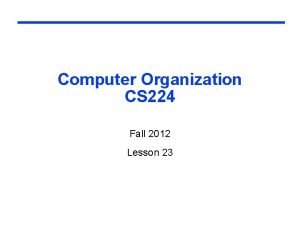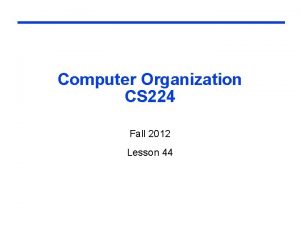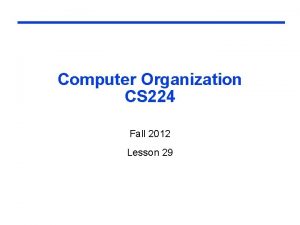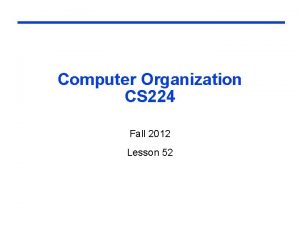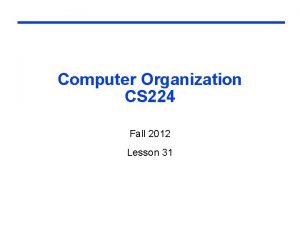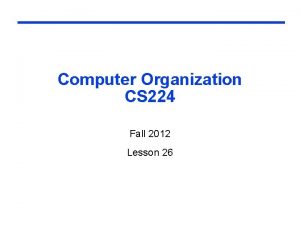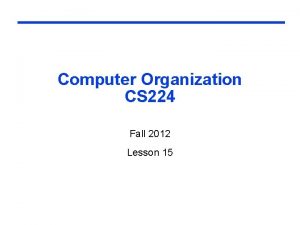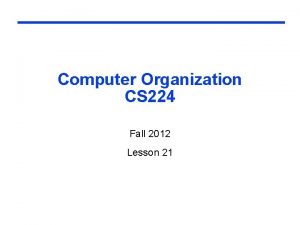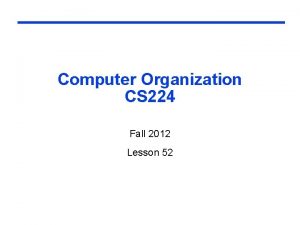Computer Organization CS 224 Fall 2012 Lessons 9



























- Slides: 27

Computer Organization CS 224 Fall 2012 Lessons 9 and 10

q MIPS procedure call instruction: jal Procedure. Address #jump and link q Saves PC+4 in register $ra to have a link to the next instruction, for the procedure return; jumps to target addr. q Machine format (J format): 0 x 03 q Procedure return copies return address to PC: jr q 26 bit address $ra #return to callpoint+4; Instruction format (R format): 0 31 0 x 08 § 2. 8 Supporting Procedures in Computer Hardware Instructions for Accessing Procedures

Six Steps in Execution of a Procedure 1. Main routine (caller) places parameters in a place where the procedure (callee) can access them l $a 0 - $a 3: four argument registers 2. Caller transfers control to the callee (jal Dest) 3. Callee acquires the storage resources needed 4. Callee performs the desired task 5. Callee places the result value in a place where the caller can access it l 6. $v 0 - $v 1: two value registers for result values Callee returns control to the caller (jr $ra) l $ra: one return address register to return to the point of origin

Register Usage q $a 0 – $a 3: arguments (reg’s 4 – 7) q $v 0, $v 1: result values (reg’s 2 and 3) q $t 0 – $t 9: temporaries (reg’s 8 -15, 24 -25) l q Can be overwritten by callee $s 0 – $s 7: saved (reg’s 16 -23) l Must be saved/restored by callee ! q $gp: global pointer for static data (reg 28) q $sp: stack pointer (reg 29) q $fp: frame pointer (reg 30) q $ra: return address (reg 31) q $gp, $sp, $fp, $ra must be saved/restored by callee !

MIPS Register Convention Name Register Number Usage Preserve on call? $zero 0 constant 0 (hardware) n. a. $at 1 reserved for assembler n. a. $v 0 - $v 1 2 -3 returned values no $a 0 - $a 3 4 -7 arguments no $t 0 - $t 7 8 -15 temporaries no $s 0 - $s 7 16 -23 saved values yes $t 8 - $t 9 24 -25 temporaries no $k 0 - $k 1 26 -27 reserved for op system n. a. $gp 28 global pointer yes $sp 29 stack pointer yes $fp 30 frame pointer yes $ra 31 return addr (hardware) yes

Stack Usage q Both caller and callee use a stack – a last-in-first-out queue q high addr top of stack $sp One of the general registers, $sp ($29), is used to address the stack (which “grows” down, from high address to low address) l add data onto the stack – push $sp = $sp – 4 put data on stack at new $sp l remove data from the stack – pop get data from stack at $sp = $sp + 4 low addr

Leaf Procedure Example q C code: int leaf_example (int g, h, i, j) { int f; f = (g + h) - (i + j); return f; } l Arguments g, …, j in $a 0, …, $a 3 l f in $s 0 (hence, need to save $s 0 on stack) Return result in $v 0 l

Leaf Procedure Example q MIPS code: leaf_example: addi $sp, -4 sw $s 0, 0($sp) Save $s 0 on stack add sub $t 0, $a 1 $t 1, $a 2, $a 3 $s 0, $t 1 Procedure body add $v 0, $s 0, $zero Result to$v 0 for return lw $s 0, 0($sp) addi $sp, 4 Restore $s 0 jr Return $ra Note: it can be done in 4 lines (2 add, sub, jr) if $s 0 is not used

Stacking of Subroutine Environments q Procedures are often nested, there are multiple calls and returns q C is a “leaf” procedure, but B is a nested (non-leaf) procedure q The stack grows downward at each new call, shrinks upward at each return A A: CALL B A B B: CALL C C: RET A B C A A B

Non-Leaf Procedures q Procedures that call other procedures q For nested call, caller needs to save on the stack: l l Its return address Any arguments and temporaries it still needs after the call (which are not in saved registers) q Restore from the stack after the call q As with leaf procedures, callee also needs to save on the stack any “saved” registers, & restore them at end

Non-Leaf Procedure Example q C code: int fact(int n) { if (n < 1) return (1); else return n * fact(n - 1); } l Argument n in $a 0 l Return result in $v 0

Non-Leaf Procedure Example q MIPS code: fact: addi $sp, -8 sw $ra, 4($sp) sw $a 0, 0($sp) slti beq addi jr L 1: $t 0, $v 0, $sp, $ra $a 0, 1 $zero, L 1 $zero, 1 $sp, 8 # adjust stack for 2 items # save return address # save argument # test for n < 1 # if so, result is 1 # pop 2 items from stack # and return addi $a 0, -1 jal fact # else decrement n # recursive call lw lw addi mul jr # # # $a 0, $ra, $sp, $v 0, $ra 0($sp) 4($sp) $sp, 8 $a 0, $v 0 restore original n and return address pop 2 items from stack multiply to get result and return

Local Data on the Stack q Local data allocated by callee l q Procedure frame (aka activation record) l q e. g. , C automatic variables Used by some compilers to manage stack storage The frame pointer ($fp) points to the first word of the frame of a procedure – providing a stable “base” register for the procedure

Using Registers to Implement Procedures q Caller l l l q Callee Setup l Step 1: Allocate memory in frame ($sp = $sp - frame) Step 2: Save callee-saved registers $s 0 -$s 7, $fp, $ra (if their values will be changed) l Step 3: Create frame ($fp = $sp + frame size - 4) l q Save caller-saved registers $a 0 -$a 3, $t 0 -$t 9 (if their values need preserving) Load arguments in $a 0 -$a 3 (rest on stack above $fp) Execute jal instruction Callee Return l Place return value in $v 0 and $v 1 l Restore any callee-saved registers ($fp, $ra, $s 0 -$s 7…) l Pop stack ($sp = $sp + frame size) l Return using jr $ra

Calling Convention: Steps Before call: FP SP First four arguments passed in registers Callee setup; step 1 FP SP Adjust SP Callee setup; step 2 FP SP Callee setup; step 3 FP SP ra old FP $s 0 -$s 7 Save registers as needed ra old FP $s 0 -$s 7 Adjust FP

Memory Layout q Text: program code q Static data: global variables q q l e. g. , static variables in C, constant arrays and strings l $gp is initialized to address 10008000, allowing +/- offsets into this segment Dynamic data: heap l For structures that grow and shrink, e. g. linked lists, trees, etc l Allocate using malloc in C, (new in Java); free it with free in C (automatic garbage collection in Java) Stack: storage of automatic variables (local to a procedure)

q Byte-encoded character sets l ASCII: 128 characters (= 7 -bit) - 95 graphic (i. e printable), 33 control l Latin-1: 256 characters (= 8 -bit) - ASCII, +96 more graphic characters q Unicode: universal character set l Used in Java, C++ wide characters, … l Most of the world’s alphabets, plus symbols UTF-16 is the default (16 -bit encoding for each character) UTF-32 is 32 -bits per character UTF-8 is variable length: 8 -bits to handle ASCII, plus 16 -32 bits for other characters l l l § 2. 9 Communicating with People Character Data

Byte/Halfword Operations q Could use bitwise operations—so why not? l q String processing is a common case MIPS byte/halfword load/store operations --lb rt, offset(rs) l Sign extend to 32 bits in rt --lbu rt, offset(rs) l lhu rt, offset(rs) Zero extend to 32 bits in rt --sb rt, offset(rs) l lh rt, offset(rs) sh rt, offset(rs) Store just rightmost byte/halfword

String Copy Example q C code (naive): l Null-terminated ASCII string void strcpy (char x[], char y[]) { int i; i = 0; while ((x[i]=y[i])!='�') # copy x y until null i += 1; } l l Addresses of x, y in $a 0, $a 1 i in $s 0

String Copy Example q MIPS code: strcpy: addi sw add L 1: add lbu add sb beq addi j L 2: lw addi jr $sp, $s 0, $t 1, $t 2, $t 3, $t 2, $s 0, L 1 $s 0, $sp, $ra $sp, -4 0($sp) $zero, $zero $s 0, $a 1 0($t 1) $s 0, $a 0 0($t 3) $zero, L 2 $s 0, 1 0($sp) $sp, 4 # # # # push $s 0 onto stack i = 0 addr of y[i] in $t 1 $t 2 = y[i] addr of x[i] in $t 3 x[i] = y[i] exit loop if y[i] == 0 i = i + 1 next iteration of loop pop $s 0 from stack and return [Bottom testing & pointer addressing saves 2 lines from the loop. Not using s 0 saves 4 other lines. ]

q We'd like to be able to load a 32 -bit constant into a register, for this we must use two instructions q a new "load upper immediate" instruction lui $t 0, 10101010 16 q 0 8 10101010 2 Then must get the lower order bits right, use ori $t 0, 1010101010101010 0000000000000000 1010101010101010 § 2. 10 MIPS Addressing for 32 -Bit Immediates and Addresses 32 -bit Constants

Branch Addressing q Branch instructions specify l l q Opcode, two registers, target address beq $t 0, $s 3, Loop. End Most branch targets are near branch l Forward or backward (max is ± 215) q op rs rt constant or address 6 bits 5 bits 16 bits PC-relative addressing l l Target address = PC + offset × 4 PC already incremented by 4 by this time

Other Control Flow Instructions q MIPS also has an unconditional branch instruction or jump instruction: j q label #go to label Instruction Format (J Format): 0 x 02 26 -bit address from the low order 26 bits of the jump instruction 26 00 32 4 PC 32

Jump Addressing q Jump (j and jal) targets could be anywhere in text segment Encode full address in instruction l q op address 6 bits 26 bits Pseudo-Direct jump addressing l Target address = PC 31… 28 : (address × 4)

Target Addressing Example q Loop code from earlier example l Assume Loop at location 80000 $t 1, $s 3, 2 80000 0 0 19 9 2 0 add $t 1, $s 6 80004 0 9 22 9 0 32 lw $t 0, 0($t 1) 80008 35 9 8 0 bne $t 0, $s 5, Exit 80012 5 8 21 2 addi $s 3, 1 80016 8 19 19 1 j 80020 2 Loop: sll Exit: … Loop 80024 20000

Branching Far Away q What if the branch destination is further away than can be captured in 16 bits? q The assembler comes to the rescue – it inserts an unconditional jump to the branch target and inverts the condition beq $s 0, $s 1, L 1_far bne j $s 0, $s 1, L 2 L 1_far becomes L 2:

Addressing Mode Summary
 Cs-224 computer organization
Cs-224 computer organization Process organization in computer organization
Process organization in computer organization Basic structure of a computer system
Basic structure of a computer system Diff between computer organization and architecture
Diff between computer organization and architecture Complete computer description in computer organization
Complete computer description in computer organization Interrupt cycle flow chart
Interrupt cycle flow chart Concrete crack comparator card
Concrete crack comparator card Kohlberg stages
Kohlberg stages Score de genève modifié simplifié
Score de genève modifié simplifié Asw 224
Asw 224 Ece 224
Ece 224 Bivariate linear regression
Bivariate linear regression Prin trecerea acetilenei prin tuburi ceramice
Prin trecerea acetilenei prin tuburi ceramice Cs 224
Cs 224 224 binary
224 binary Stanford cs224w
Stanford cs224w Soc 224
Soc 224 Km 224
Km 224 Uç alkin
Uç alkin Km 224
Km 224 Km 224
Km 224 Mat 224
Mat 224 Ece 224
Ece 224 Dea number
Dea number 224+48
224+48 224+48
224+48 Cs 224
Cs 224 Cs 224
Cs 224
